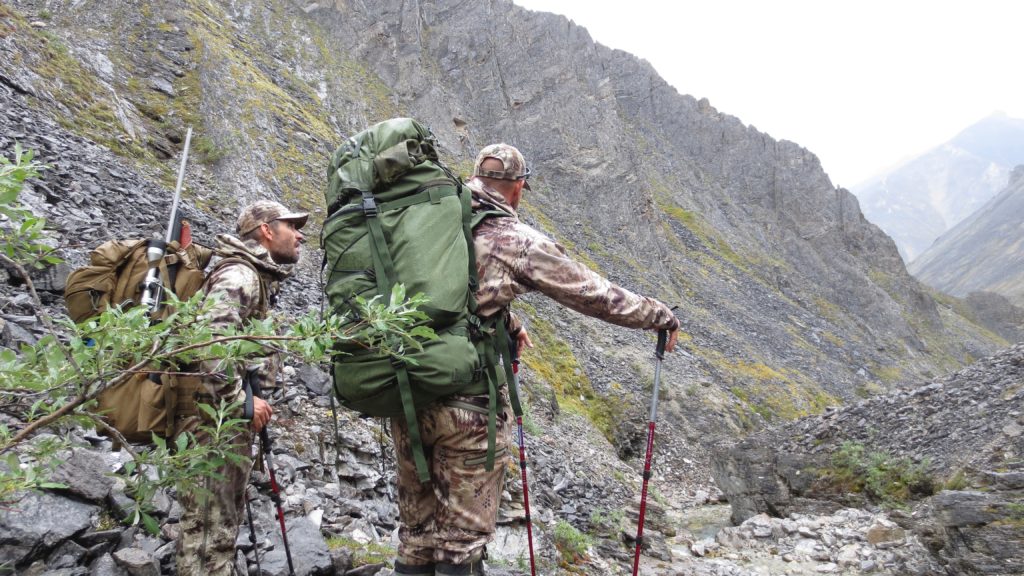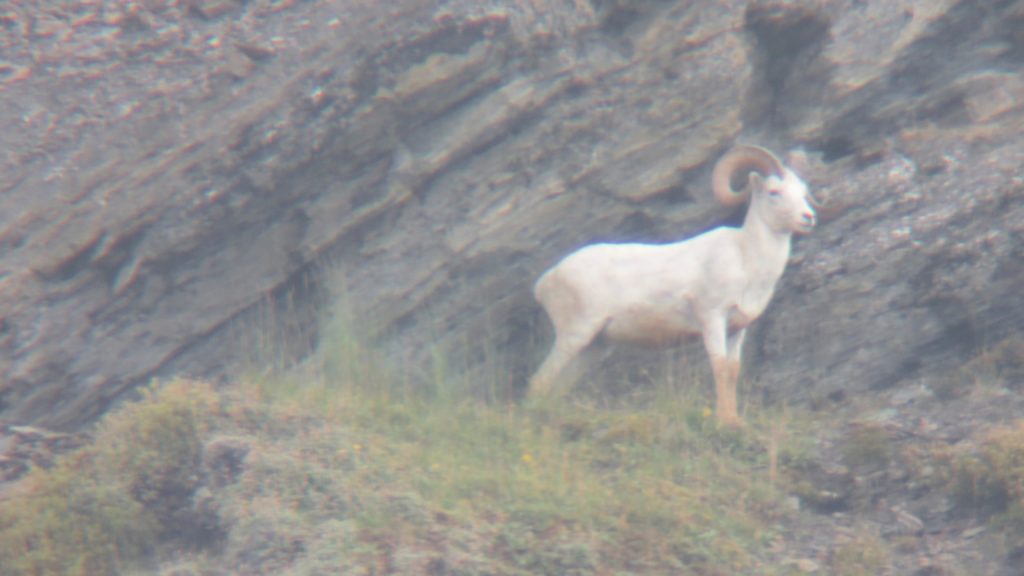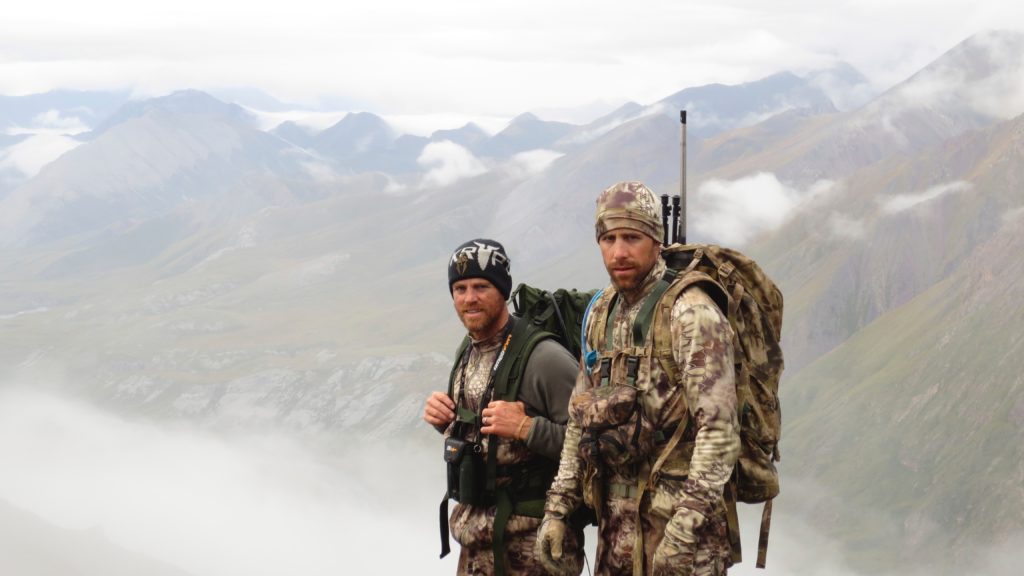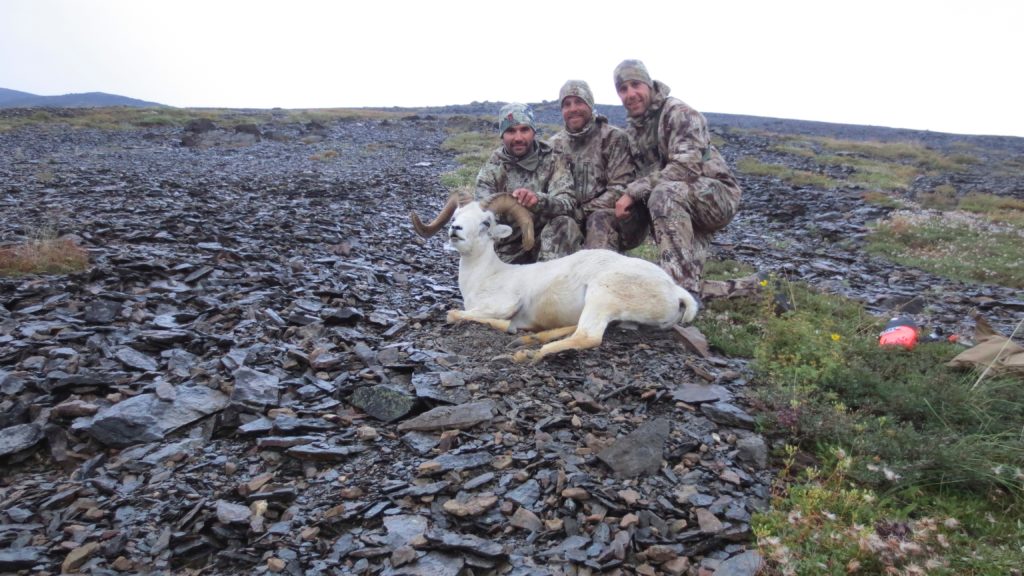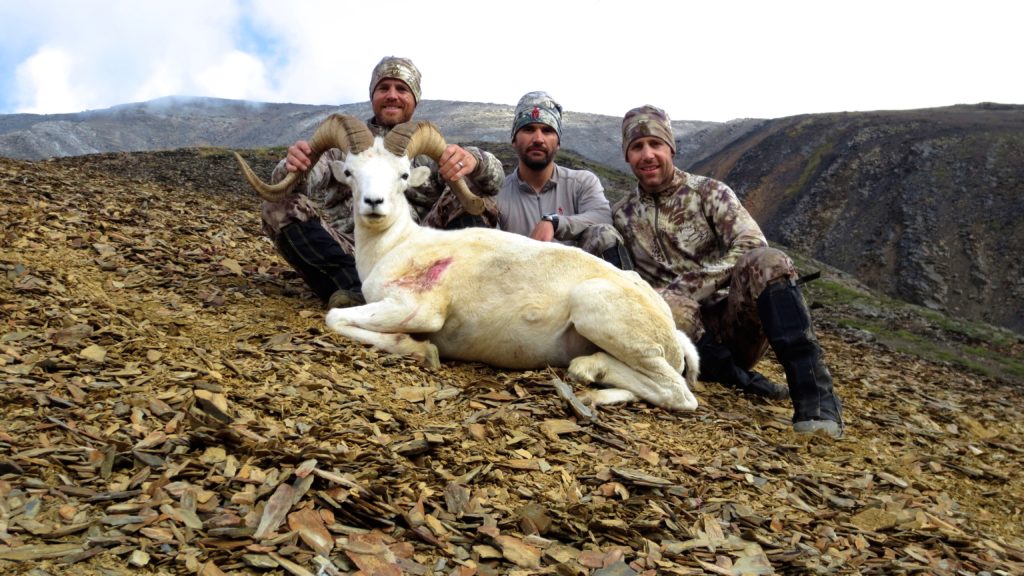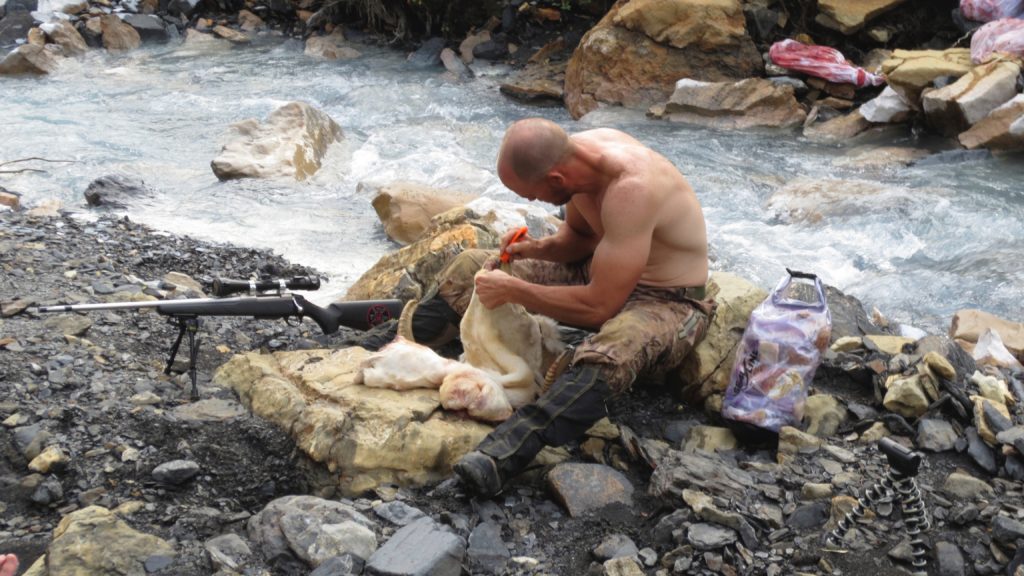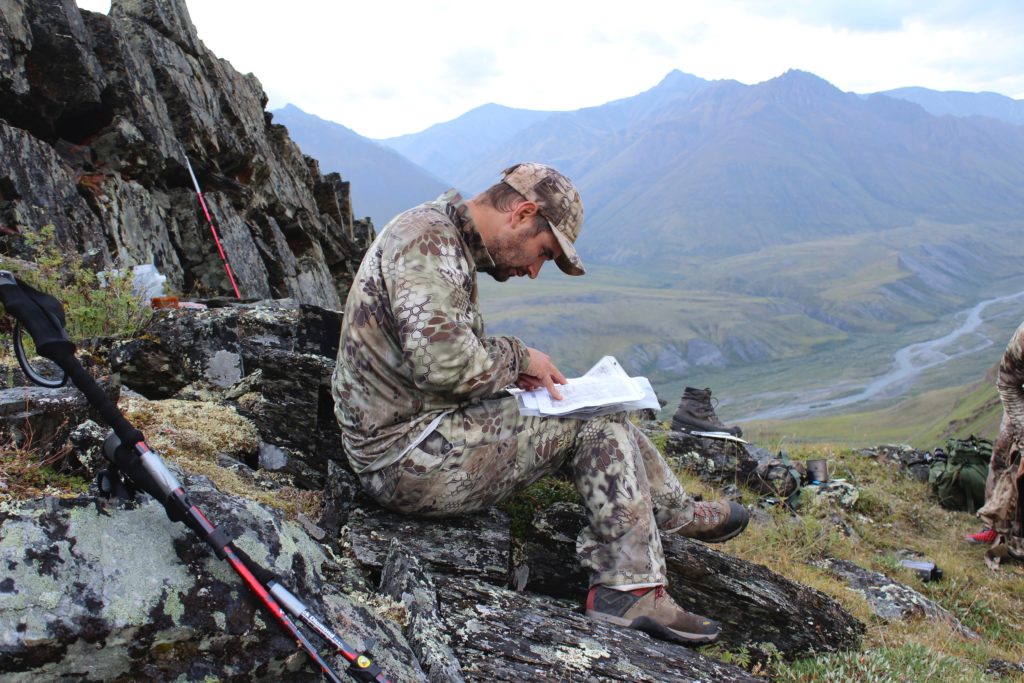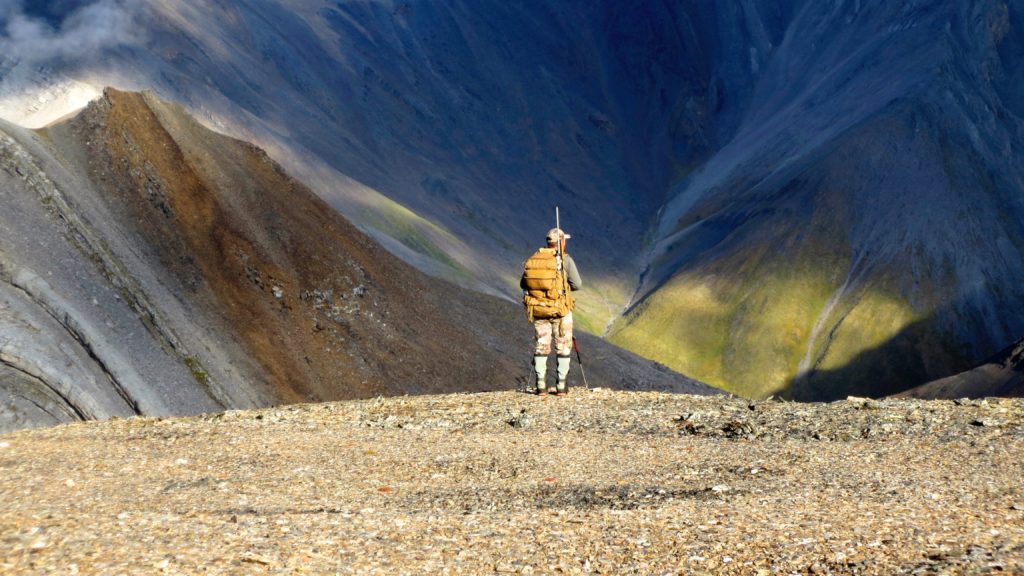Best Laid Plans
Anyone who has traveled the high peaks in pursuit of Dall sheep knows that a hunt of this magnitude brings with it extreme highs and extreme lows. The physical beating and emotional roller coaster that one’s body and mind endure are unlike any other I have ever experienced. Our 2013 Alaska trip was indeed one of those hunts.
Along with my brother Kenton, my buddy Terry and I found ourselves sitting at Wright Air Service waiting for our names to be called, the air was filled with palpable anticipation. Once we were in the plane and airborne to our destination, the excitement grew. The three of us had been planning this hunt for over a year and been poring over maps for the last six months, discussing drainages and potential campsites over phone conferences, building a solid plan that, we hoped, would give us the highest chance of filling three sheep tags. We’d covered every detail multiple times and had contingency plans in place. We were ready.
As the plane touched down along the riverbed, we unloaded, thanked our pilot, and were left with the moment we had been waiting for — our much-anticipated Dall sheep hunt. We immediately pulled out our maps and the GPS to get ourselves oriented. Stepping off the plane, the area just didn’t look quite how I had imagined. After hours of scouring topographical maps and Google Earth I had a pretty good mental picture of what this area would look like, and the place we were standing did not look anything like what I’d envisioned. Once we gained satellite connection with the GPS, my fears were confirmed. This was not the airstrip where we’d planned on being dropped. In fact, we were standing 11 miles away from that area. We immediately called and talked with the air service. After a short conversation, they confirmed that we were at the only strip near our desired hunt location, and that the strip we had in mind did not exist.
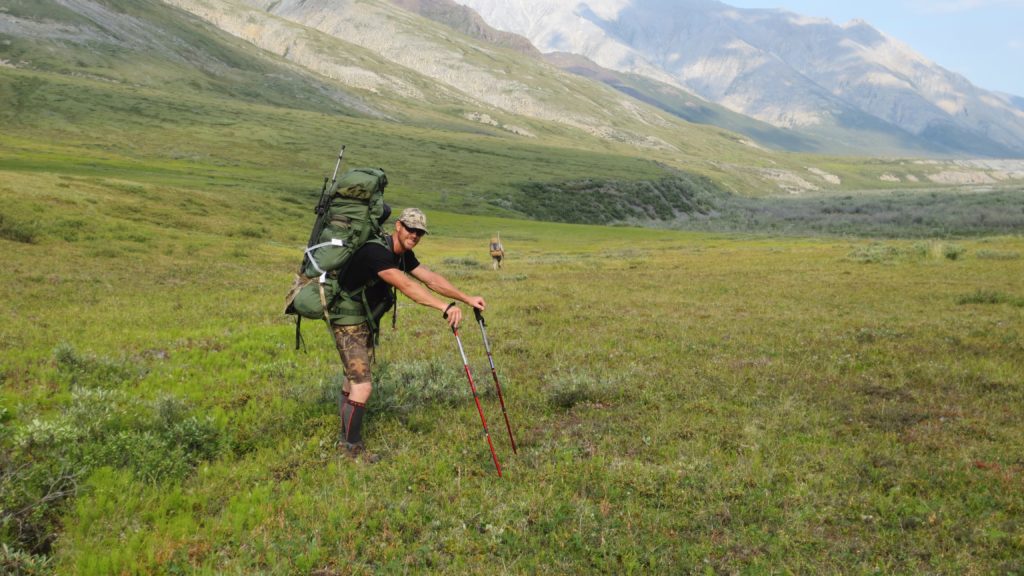
Back to the Beginning
After some discussion, we made the painful decision to start walking to the location upon which we’d focused all of our planning efforts. Five and a half miles later in 70+ degree weather, we’d had enough and decided to push up into the sheep mountains and hunt our way to our desired drainages. We had been beating the ground for too long, and the country surrounding us looked great. It was time to start scouting and looking for sheep.
We all put six extra liters of water in our already-heavy packs and headed straight up the mountain. Our packs at this point were over 85 pounds, and gaining the 2,000 feet of elevation was taxing to say the least. We finally found a little bench on which to set up our tent and make our first camping spot. Not long after making camp, we started spotting sheep. A decent ram was spotted about a mile away and, after putting the spotter on him, we all decided he would be worth pursuing the following day — still one day away from the opener.
The Pursuit of Ol’ Black Eye
Day two brought more great weather. We packed up a day’s supply of food and water and headed out to do some scouting. The farther back we pushed, the better the country looked and the more sheep we started seeing. We made it into a saddle about three miles from camp and spotted a bedded ram. After looking at him for a while, we concluded that it was the same ram from the night before. He had a distinct black ring around his left eye that made him easy to identify; we nicknamed him “Ol’ Black Eye.” He was about 600 yards away and through the spotters we could see that his right horn was definitely broomed, and possibly his left as well. To be sure, we needed a better look — but Ol’ Black Eye just wasn’t cooperating. Pretty soon he stood up and walked out of sight. Spirits were high as we headed back towards camp to pick up and bring everything forward. After a few hours, and several miles, we had our new camp set up and were once again glassing sheep.
On day three, we set out to find Black Eye and hoped to be able to sit on him that evening, with the ultimate goal of having a ram down early on opening day. We pushed back to the same saddle we had spotted him in the day before, only to find four ewes bedded down, so we circled around them and continued our search. We managed to track him down, bedded about two miles farther back. Making our way towards him, we spotted 15 ewes bedded on a ridge with a single ram that looked to be about ¾ curl on the left side, but we couldn’t see his right side. As we made our way back to Black Eye, sheep were popping up everywhere, including two younger rams. Carefully making progress, we climbed up to a vantage point that would place us looking down on where we had spotted Ol’ Black Eye earlier that morning.
As we made it to the top, I spotted one of the bands of ewes making their way through a pass, quickly began glassing, and soon spotted the ram that was with them. As soon as I saw him through the binoculars I knew he was a lot more than just a ¾ curl ram as we’d initially assessed. He was broomed hard on that side, but over full curl on the right side. He was a definite shooter and, as everyone got a look at him, the excitement built. As we sat and glassed, all the sheep we’d seen made their way up and over the pass and out of sight. We crawled around the other side to see if Black Eye was still there, but he was gone. It was around noon and we now had two possible shooters in our drainage. All we had to do was wait and hope they would return that evening to feed.
We stayed up on our vantage point for a few more hours, then decided to make our way back to camp and move it closer to the rams. Hours and miles later we were at our new campsite boiling water for dinner. Around 10:30 p.m., Ol’ Black Eye fed out onto a ridge we could see from camp. We put the glass on him, waited for him to bed down, and quickly made a plan to get around and above him. We left camp around 11 p.m., snuck around the hill past several ewes and lambs, and finally made it above him at 12:30 a.m. We put the spotter on him to get the final confirmation that he was broomed on both sides. During all of this excitement, the weather had taken a turn for the worse, and it had started to rain and blow and turned downright cold and nasty. Ol’ Black Eye still stubbornly refused to show his left horn and all we could see of the bedded ram was his right. The waiting game continued.
Black Eye Down
For 4.5 hours, we watched and nearly froze to death. We were taking shifts, one person watching the ram while two snuck back out of sight and kept warm doing push-ups, squats, burpees, hill sprints and, finally, a little space blanket wrapping. Finally, at 5 a.m. the light was good, the weather was breaking, and my brother Kenton confirmed that his left side was indeed broomed, as we had hoped. I ran back to get Terry and let him know it was go time. Terry made his way to the spotter, confirmed the double broom and crawled into shooting position. After only a few seconds behind the gun, Terry made a perfect shot on the ram. The ram’s head hit the dirt and it was over. Terry had his first ram. Ol’ Black Eye would not see another Alaskan winter.
The Gamble
We spent day four finishing the quartering of Terry’s ram and getting it back to camp. We set up a meat cache, got a quick bite to eat, and crashed around 10 a.m. for a few hours. That afternoon we made plans to take a three-day trek into some new country to look for another legal ram. We took Terry’s meat and all the extra food and supplies down to a creek 2 – 3 miles from our current camp to set up a cache and placed all the meat in double contractor bags submerged in the creek to keep cool and away from the bugs. That evening we did some glassing in hopes of spotting the other ram from two days ago, but to no avail. We went to bed ready to hike the next morning with plans to make a 10-15 mile loop over the next three days.
On day five, I woke up at 5 a.m. and made my way out of the tent. As I always do, I took a moment to carefully look at all the ridges surrounding camp. I immediately spotted three sheep feeding on a ridge about ¾ of a mile from us. I put my spotter on them and recognized one of them as the big ram from three days ago. I shook the tent and told my brother and Terry to get up — we had a ram to kill! Both of them quickly came out of the tent, looked through the spotter, and recognized the ram as well. We made a plan and got our gear together, keeping a careful eye as the sheep fed down into the creek bottom out of sight.
As we reached our pre-determined ridge, we set up and waited for the sheep to come out of the bottom. 45 minutes passed and we began to get impatient. We decided the best plan would be to move over one more ridge so we could have a look down into the creek where the rams were last headed. But just before we took off, two of the rams came out! As the rollercoaster of sheep hunting would have it, they were both sublegal. Since we knew that the big ram was likely still down there, we decided to go for it and quickly made our way down and up the other side to gain a better vantage point.
We belly-crawled to the crest of the ridge to look down into the creek. As we inched forward, Terry put his hand up giving the “freeze” signal as he whispered, “He is 20 yards from me, don’t move.” We were pinned down for 35 minutes, unable to move until the ram finally bedded down and, looking down the ridge away from us, gave Terry the opportunity to slip back out of sight and change places with Kenton. As Kenton slipped up into shooting position, the ram stood up, knowing something wasn’t right. Kenton was a second ahead of him and ready. He quickly steadied his rifle and fired. The ram bolted without hesitation and everyone thought, “Holy crap! Did Kenton miss from 20 yards?”
But our concerns were misplaced. The ram barely made it 25 yards before falling over; he was done. The celebration began and everyone exhaled as the realization that we had another ram down sunk in. It had been the longest 35 minutes of our lives, lying there without movement as we waited for that ram to settle. Kenton had just killed his first Dall sheep and so far, we were two days into the season and had two rams down.
We made it down to the ram, took pictures, and made quick work of getting him quartered, bagged and ready for transport. We decided to walk him down to the main creek drainage about a mile from where Terry’s ram was cached. It was about a two-mile hike and all downhill. We spent most of the day at our new meat cache location bringing Terry’s ram and all the extra gear and food to one spot. We set up a tarp to keep the meat dry and laid it on branches to keep it off the ground. We grabbed some tenderloins from both sheep and headed back to camp ready for an evening of fresh sheep meat and a good night’s rest in anticipation of going after one last ram.
Going For the Triple
On day six we woke up early, broke down camp, and headed north on our predetermined path over a mountain pass that would put us in the next drainage. This stretch of mountain terrain turned out to be the worst two miles I have ever walked. It was full of boulders, and with every step we wondered if the whole mountainside was going to collapse. It took us six hours to travel that short distance and everyone was completely exhausted by the time we came out the other side.
We spent the next three days hiking our tails off and spending hours behind the glass. The weather and the fog had moved in on us, making it difficult to spot sheep. Regardless, we hiked from one ridge to another, hopeful that we’d spot a ram. We only spotted a few during that time, and one nearly full curl ram taunted us just 300 yards from our tent. With no legal rams over the past couple of days it was time to head back to our cache.
When we arrived back at the meat cache, we discovered an animal had taken one bag of scrap meat, dragged Kenton’s sheep horns across the creek, and ripped his cape to shreds. It wasn’t a complete loss, and we considered ourselves lucky all things considered. After loading all the meat and gear into our packs we made our way down the creek about two miles to our next camp with plans to hunt one more drainage before heading back to the strip.
Of course it rained the entire trek, but we took heart in the fact that we had heavy packs and were doing what we love most. We made it to our next camping location, got set up, and built a fire to help dry out gear as it had stopped raining. We had some well-deserved food and enjoyed the campfire camaraderie while planning for the next day’s hunt.
The Final Days
On day nine, we woke up early to more low-lying fog, but no rain, so we crawled out of the tent, had some breakfast and readied our packs for the final push to find my ram. As we hiked up the nearby drainage, it became very evident that the creek we were following was getting very narrow, and our route was getting downright dangerous. We found ourselves side-hilling most of the time above a creek that was roaring from all the rain we had received in the past few days. We reached a point where we had to make a pretty butt-puckering side-hill and after reaching the creek bottom we stopped to gather our thoughts and decide whether we should continue.
Since it was my ram that we were after, I made the final call to say it wasn’t worth it. My brother and Terry agreed, and knowing that they would walk through anything to get me my ram was enough for me. It’s awesome to have such great hunting partners that work as hard for you as they work for themselves.
We turned around, made it back to an adjacent drainage, and pushed up into the head of it to see if any rams were calling it home. As my (bad) luck would have it, once we made it to the head, the fog had really settled in, and only half the ridges were visible. We stayed there until the evening hoping something would materialize, but the day ended without seeing any sheep.
On the tenth day, we awoke to more fog and decided it was time to make the four-mile trek to the airstrip. We made it back in a few hours and began setting up our last camp for the trip. Later that day the fog had lifted enough to see across the river, where we spotted what we were sure was a legal ram. We watched him for much of the remainder of the day and even made a walk to the river to see if crossing was feasible. We concluded that it just wouldn’t be safe. The weather was getting cold, highs were in the 50s, and the river was white capped, moving extremely fast, and looked very deep. It was quite a change from just 10 days ago, when the river was barely moving and temps were in the high 70s, but that’s Alaska! We made plans to head out the next morning and hunt the drainage on our side of the river. It would be our last effort at filling the third tag.
Our eleventh day brought more fog but we hiked up the shrouded drainage and made a push to the top — about 2,500 vertical feet. As we traversed the ridges at the head of the drainage, the fog began to burn off. It took most of the day to cover all the terrain and the rain was a constant companion. We did end up spotting several sheep, and many were rams, but unfortunately none were legal. As the day progressed, the realization was starting to sink in that taking that third ram was not going to happen.
We made our way back to camp in the rain and fog, and my body was feeling the fatigue of the past 11 days. We finally arrived in camp that evening and had some dinner, got a nice fire going, and talked about our adventure. We were all ready for a warm bed and shower, but at the same time would miss being in the sheep mountains. As we went to bed that night, we all had a deep feeling of satisfaction and respect for the animals that call these mountains home.
On the last day, we woke up feeling a bit refreshed after a good night’s rest. We had some breakfast and waited with uncertainty about our pick-up, due to the thick fog. It wasn’t raining but the ceiling was very low. To pass the time, we picked up around camp, readied our packs, and waited for the sound of the Helio. Early in the afternoon, we heard the undeniable hum of the airplane coming to pick us up. We loaded up and soon were headed back to Fairbanks for a desperately-needed shower, a hot meal, and contact with our families.
Unfinished Business
Having only one other sheep hunt under my belt, I learned a lot on this second adventure. I look forward to doing it again and, God willing, I will. A very well respected sheep hunter once said, “The year you start sheep hunting is the year your first ram is born.” I now understand what that wise hunter was trying to tell me. Every time you set out to hunt these animals, you learn how to do it better the next time. There are things we did right on this trip, but there are certainly things I will not do again on the next go-around. I have a deep respect and maybe even a bond with these elusive and majestic animals that only those who have set boots to ground and eyes to glass in their domain can fully understand.


